To protect your smartphone camera while traveling, invest in a high-quality case with raised edges around the lens. Clean the lens gently with a microfiber cloth and avoid moisture exposure. Keep your device away from extreme temperatures and dust. Regularly update your camera software for peak performance. Back up your photos to cloud storage or external drives. In diverse climates, take precautions like using waterproof cases in humid areas or keeping your phone close to your body in cold weather. Don't forget to pack cleaning supplies and consider additional accessories for enhanced protection. Discover more tips to guarantee your smartphone camera stays in top shape throughout your adventures.
Protective Cases for Smartphone Cameras

For travelers, protecting your smartphone's camera is essential. A high-quality protective case can shield your device from accidental drops, scratches, and environmental hazards.
Look for cases that offer raised edges around the camera lens to prevent direct contact with surfaces when you set your phone down. Some cases feature a sliding cover or built-in lens cap to provide extra protection when you're not using the camera.
Consider water-resistant or waterproof cases if you'll be near water or in humid environments. These can safeguard your phone's delicate camera components from moisture damage.
For adventure travelers, rugged cases with reinforced corners and shock-absorbing materials offer maximum protection against impacts and rough handling.
Don't forget about screen protectors, which can indirectly protect your camera by preventing cracks that might spread to the lens area.
When choosing a case, make certain it doesn't interfere with your camera's functionality, such as blocking the flash or affecting image quality.
Opt for cases made from materials that won't yellow over time, as this can impact your photos.
Lens Cleaning Techniques On-The-Go

When you're traveling, keep a compact cleaning kit with a microfiber cloth and lens-safe solution for your smartphone camera.
Gently wipe the lens in a circular motion, starting from the center and moving outward, to remove fingerprints and smudges without scratching.
Be cautious of moisture exposure, and never use harsh chemicals or abrasive materials that could damage your device's delicate optics.
Quick Cleaning Kit Essentials
Packing a compact cleaning kit can make all the difference in keeping your smartphone camera lens pristine while traveling. Your kit should include a microfiber cloth, which is gentle on the lens and effective at removing smudges and fingerprints.
Add a small bottle of lens cleaning solution for tougher grime, but utilize it sparingly to avoid damaging your device. Include a soft-bristled brush to sweep away dust and debris without scratching the lens.
Pre-moistened lens wipes are convenient for quick cleanups, but confirm they're specifically designed for electronics. A small air blower can help dislodge particles from hard-to-reach areas around the lens.
Don't forget a protective case for your cleaning supplies to keep them organized and prevent contamination. If you're heading to humid environments, pack silica gel packets to absorb moisture and prevent fungal growth on your lens.
Lastly, include a few cotton swabs for precision cleaning of the lens edges and surrounding areas. With these essentials, you'll be prepared to maintain your smartphone's camera quality throughout your travels, guaranteeing clear and crisp photos of your adventures.
Safe Wiping Methods
Proper wiping technique is essential for maintaining your smartphone camera's lens while traveling. Always use a gentle, circular motion when cleaning the lens, starting from the center and moving outward. This helps prevent scratches and guarantees you're not just pushing debris around. Remember to use minimal pressure; let the cleaning cloth do the work.
For stubborn smudges, you can slightly dampen your microfiber cloth with lens cleaner or distilled water. But be careful not to oversaturate, as excess liquid can seep into your device. After using a damp cloth, follow up with a dry one to remove any remaining moisture.
When you're in a pinch and don't have your cleaning kit, your breath can help create a light fog on the lens. Quickly wipe it with a clean, soft fabric like a cotton t-shirt or bandana. However, this should be a last resort, as it's not as effective or safe as proper cleaning tools.
- A hiker carefully wiping their phone's lens with a microfiber cloth after a dusty trail
- A tourist using their breath to fog up the camera before wiping it with a bandana
- A traveler gently cleaning their smartphone's lens in a circular motion at a café table
Avoiding Moisture Damage
Moisture is your smartphone camera's nemesis while traveling. To protect your device from water damage, always carry a waterproof case or bag, especially in humid climates or near bodies of water.
When not in use, store your phone in a dry, cool place away from direct sunlight and heat sources.
If you're caught in unexpected rain, quickly shield your phone and wipe it down with a microfiber cloth. Don't use your phone in steamy environments like saunas or hot springs, as condensation can form inside the device.
Be cautious when taking photos near water sources, and avoid submerging your phone unless it's specifically designed for underwater use.
If your phone does get wet, power it off immediately and remove the battery if possible. Don't attempt to charge it or use a hairdryer, as this can push moisture further into the device.
Instead, place it in a sealed container with silica gel packets or uncooked rice to absorb moisture. Wait at least 48 hours before turning it on again.
For severe cases, consider professional repair services to prevent long-term damage to your smartphone's camera and other components.
Avoiding Moisture and Dust
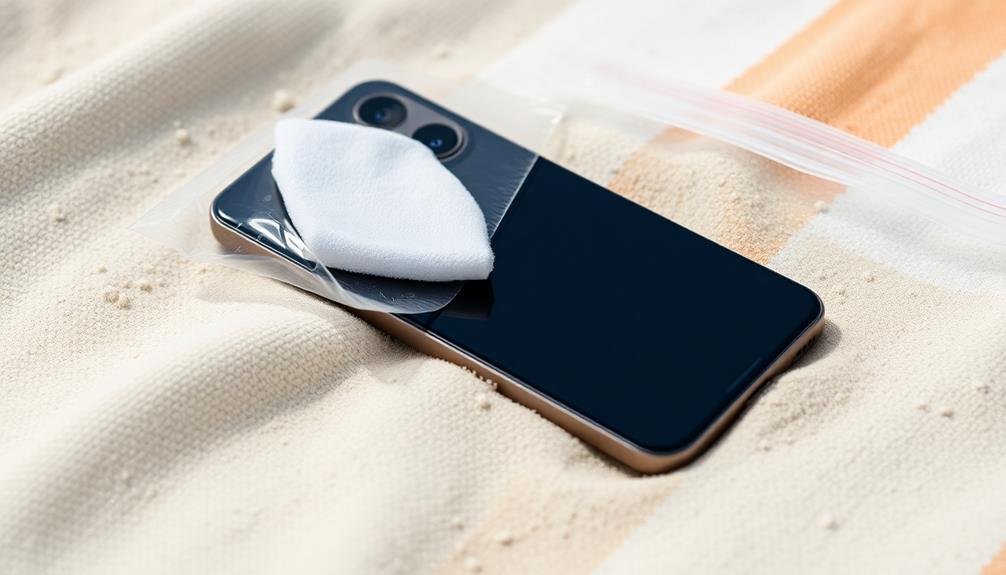
When traveling in and out of various environments, your smartphone camera can easily fall victim to moisture and dust. These elements can damage your device's sensitive components and compromise image quality.
To protect your camera, always keep it in a waterproof case or bag when not in use, especially in humid or dusty conditions. If you're heading to the beach or desert, consider using a protective sleeve or pouch specifically designed for smartphones.
Regularly clean your camera lens with a microfiber cloth to remove fingerprints, smudges, and dust particles. Avoid using harsh chemicals or abrasive materials that could scratch the lens.
When shifting between extreme temperature changes, let your phone acclimate gradually to prevent condensation from forming inside the device.
Be mindful of your surroundings and potential hazards:
- Sand blowing in the wind at the beach
- Sudden rain showers in tropical locations
- Dusty conditions in arid environments
If your phone does get wet, power it off immediately and remove any accessories. Dry it thoroughly with a soft cloth and consider using silica gel packets to absorb moisture.
For stubborn dust, use a can of compressed air to gently blow it away from the camera lens and other openings.
Proper Storage During Travel
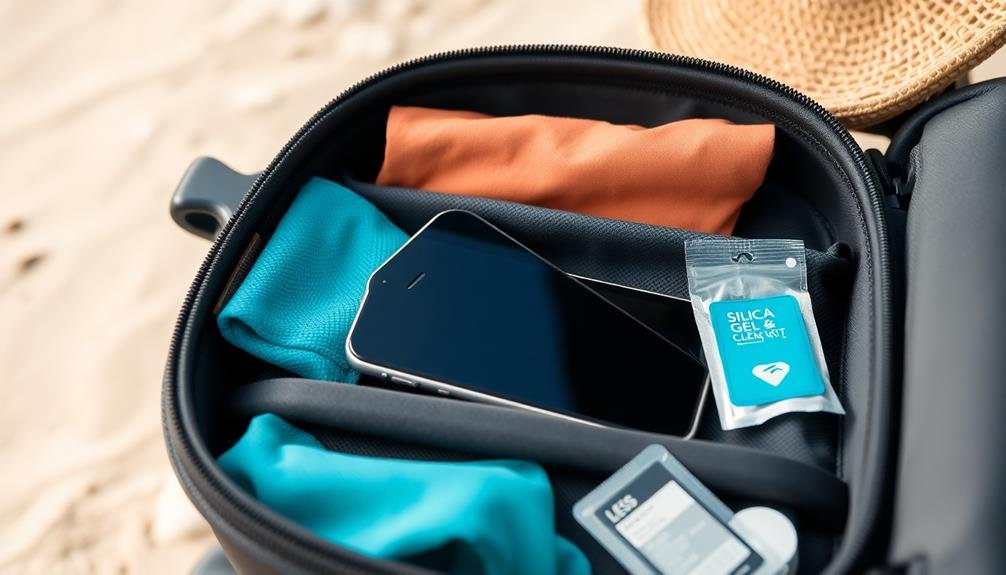
Safe storage of your smartphone during travel is essential for protecting its camera and other components. When you're not using your device, keep it in a dedicated padded case or pouch. This will shield it from accidental bumps, scratches, and drops.
If you don't have a specialized case, wrap your phone in a soft cloth before placing it in your bag.
Avoid storing your smartphone in extreme temperatures. Don't leave it in direct sunlight or a hot car, as excessive heat can damage the battery and internal components.
Similarly, protect it from extreme cold, which can affect the screen and battery performance.
Keep your phone away from items that could potentially scratch the camera lens or screen. Don't store it in the same pocket as keys, coins, or other hard objects.
If you're carrying your phone in a bag, place it in a separate compartment or use a protective sleeve.
When traveling by air, keep your smartphone with you in your carry-on luggage. This prevents exposure to extreme temperatures and pressure changes in the cargo hold.
It also reduces the risk of theft or damage during baggage handling.
Temperature Considerations for Smartphones
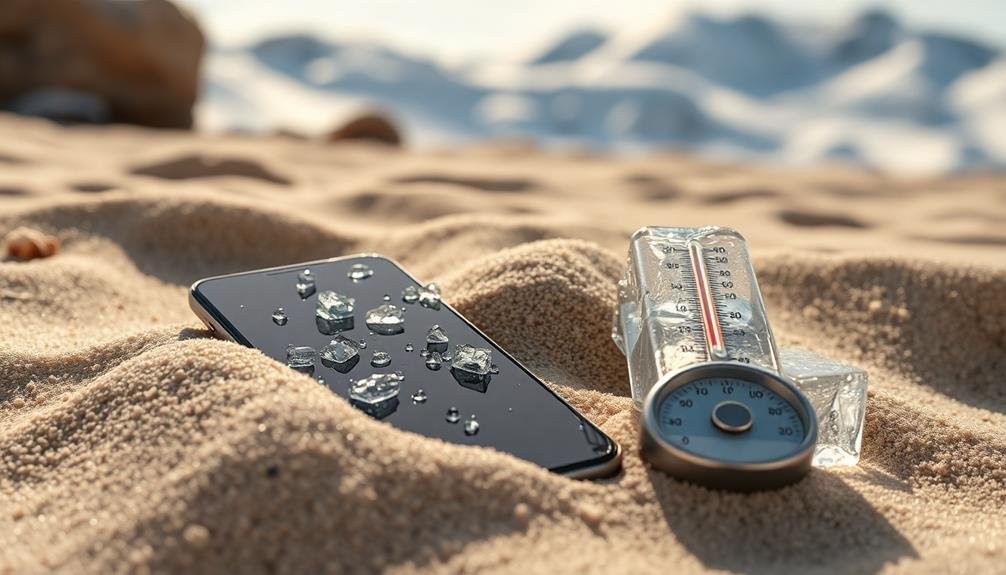
When you're traveling, it's essential to protect your smartphone from extreme temperatures.
Be aware that excessive heat can cause battery damage and system shutdowns, while cold weather may lead to temporary battery life reduction and screen issues.
To guarantee peak performance, try to keep your device within its recommended operating temperature range, typically between 32°F and 95°F (0°C to 35°C).
Extreme Heat Effects
Under scorching sun or in sweltering climates, your smartphone's camera can suffer from extreme heat exposure. High temperatures can cause various issues, including sensor damage, lens distortion, and battery degradation. These problems can greatly affect your camera's performance and image quality.
To protect your device from heat-related damage, be mindful of where you store it. Avoid leaving your phone in direct sunlight or hot cars, as temperatures can quickly rise to dangerous levels. If you're using your camera in hot conditions, try to limit exposure time and give your device breaks in cooler environments.
Heat can also affect your smartphone's internal components:
- Battery life may decrease rapidly
- Processing speed might slow down
- Screen display could become less responsive
When traveling in hot climates, consider using a protective case that offers insulation. Keep your phone in a shaded bag or pocket when not in use.
If you notice your device becoming uncomfortably warm, power it down and let it cool before resuming use. By taking these precautions, you'll help guarantee your smartphone camera remains functional and continues to capture high-quality images throughout your travels, even in extreme heat conditions.
Cold Weather Precautions
Just as extreme heat can damage your smartphone camera, cold weather poses its own set of challenges. When temperatures drop, your device's battery life can considerably decrease, and sudden temperature changes may cause condensation inside the camera lens. To protect your smartphone in cold conditions, keep it close to your body for warmth and use an insulated case.
Be cautious when moving between cold outdoor environments and warm indoor spaces. Allow your phone to gradually adjust to the new temperature to prevent moisture buildup. If condensation occurs, wait for it to dissipate before using your camera.
Here's a quick reference guide for cold weather smartphone care:
| Temperature Range | Precautions | Effects |
|---|---|---|
| 32°F to 0°F (0°C to -18°C) | Use insulated case, keep close to body | Reduced battery life |
| 0°F to -20°F (-18°C to -29°C) | Limit exposure, use hand warmers | Potential screen damage |
| Below -20°F (-29°C) | Avoid use, store in warm place | Risk of permanent damage |
Remember to power off your device if it gets too cold, and never leave it in a parked car during winter. By taking these precautions, you'll guarantee your smartphone camera remains functional for capturing those picturesque winter scenes.
Optimal Operating Temperatures
Understanding the ideal operating temperatures for your smartphone is key to maintaining its performance and longevity. Most smartphones function best between 32°F (0°C) and 95°F (35°C). Exposing your device to temperatures outside this range can lead to performance issues, battery drain, and potential hardware damage.
In extreme heat, your phone may shut down to protect itself. The battery can degrade faster, and the display may become less responsive. Conversely, cold temperatures can cause the battery to drain quickly and may even lead to a temporary shutdown.
To protect your smartphone from temperature-related issues:
- Store your device in a temperature-controlled environment when not in use
- Avoid leaving it in direct sunlight or in a hot car
- Use insulated cases in cold weather to maintain ideal temperature
When traveling to areas with extreme temperatures, be mindful of your phone's exposure. If you're heading to a hot beach or a snowy mountain, consider keeping your device in a protective case or bag.
When taking photos in these conditions, limit your phone's exposure to the elements. By being aware of temperature impacts, you'll safeguard your smartphone camera's functionality throughout your travels.
Charging and Battery Care
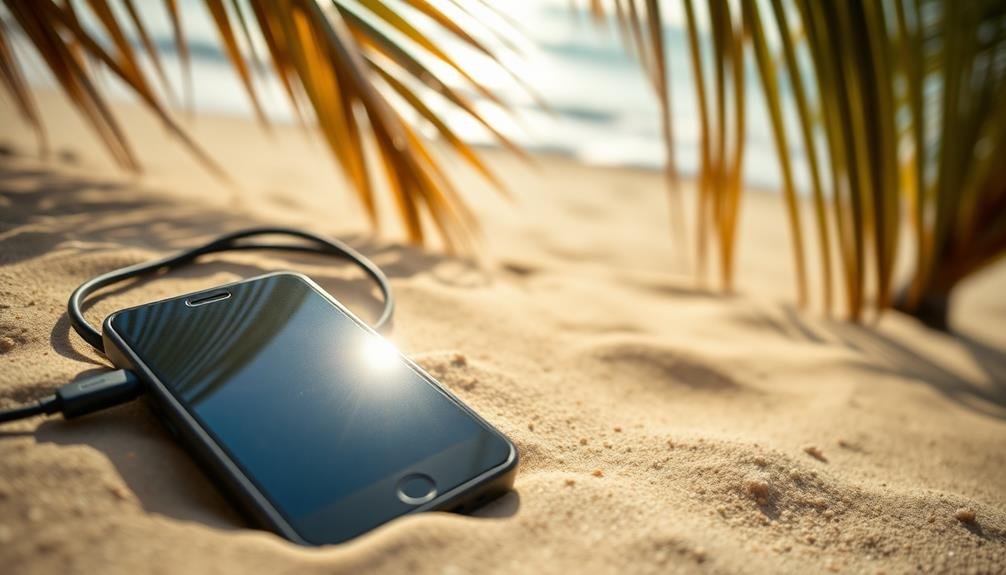
Keeping your smartphone's battery in good health is essential for capturing those perfect travel moments. To maximize battery life and performance, avoid letting your phone's charge drop below 20% or charging it beyond 80%. This practice reduces stress on the battery and slows capacity loss over time.
When traveling, always pack a high-quality charger and cable. Cheap, off-brand chargers can damage your battery or provide inconsistent power, potentially harming your phone. Consider investing in a portable battery pack for extended trips or days with heavy camera use.
Be mindful of your phone's temperature while charging. Avoid charging in direct sunlight or extremely cold conditions, as both can negatively impact battery health. If your phone feels hot while charging, unplug it and let it cool down before resuming.
Enable your phone's power-saving mode when you're not actively using the camera. This will help conserve battery life for when you need it most. Additionally, close background apps and turn off features like GPS and Bluetooth when not in use to further extend your battery's charge.
Software Updates for Camera Performance
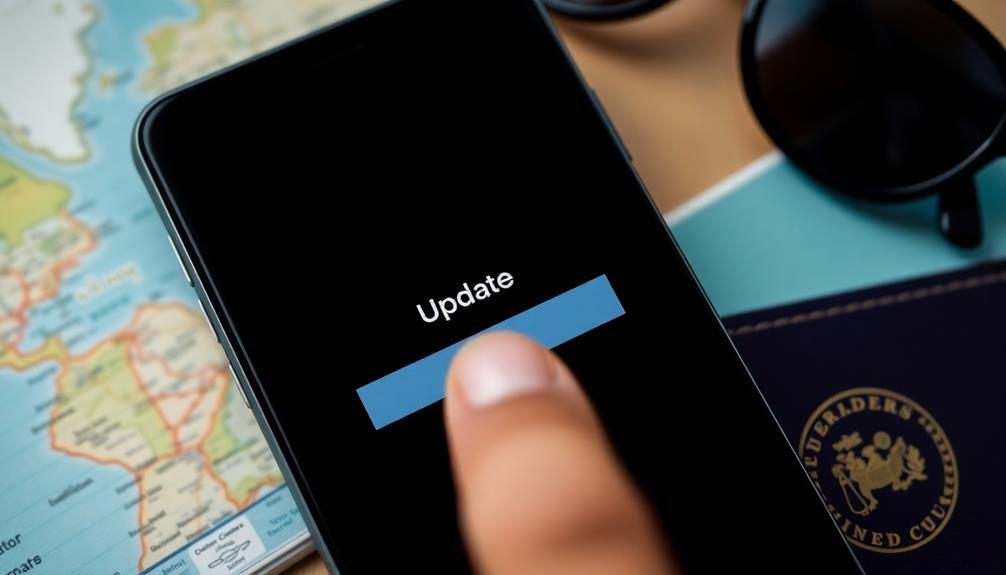
Beyond battery care, your smartphone's camera performance can be considerably enhanced through regular software updates. These updates often include improvements to image processing algorithms, new features, and bug fixes that can notably boost your camera's capabilities.
To make sure you're getting the most out of your smartphone camera while traveling, make it a habit to check for and install updates before your trip. Many manufacturers release camera-specific updates that can introduce new shooting modes, enhance low-light performance, or improve image stabilization.
Don't forget to update your third-party camera apps as well. These often provide additional features and editing tools that can elevate your travel photography. When you're on the road, connect to secure Wi-Fi networks to download updates, as they can be large and consume considerable data.
Here's what regular software updates can do for your smartphone camera:
- Enhance image quality and color accuracy
- Introduce new shooting modes like night mode or portrait mode
- Improve autofocus speed and accuracy
Backup and Storage Solutions
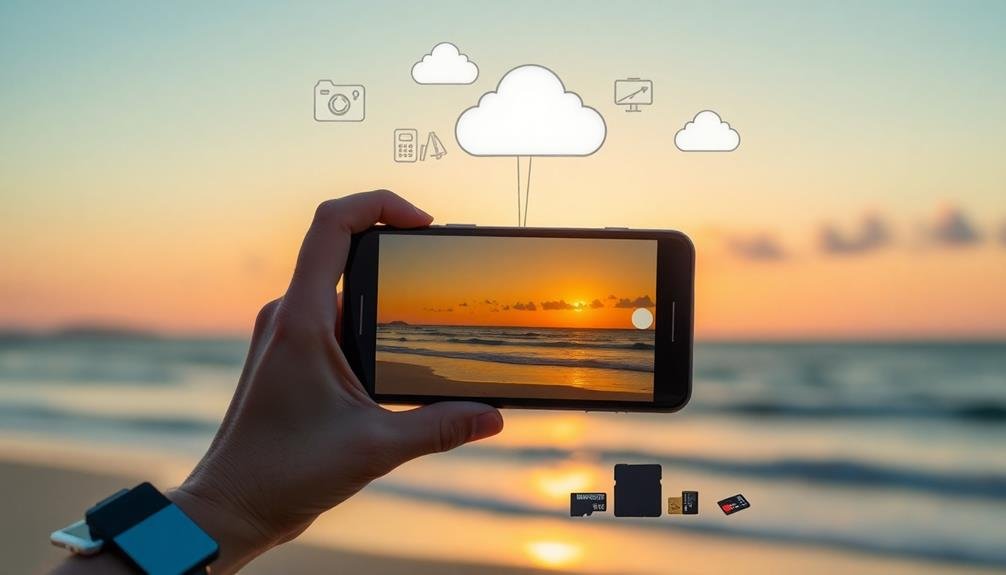
Regularly backing up your travel photos is essential for preserving your memories. Don't risk losing your precious images due to device failure or theft. Instead, utilize cloud storage services like Google Photos, iCloud, or Dropbox to automatically sync your photos as you capture them.
These services often offer free storage tiers and can be set to upload only when connected to Wi-Fi to conserve data.
For added security, consider carrying a portable hard drive or high-capacity USB stick to create local backups. Many of these devices now come with smartphone-compatible connectors, allowing you to transfer files directly from your phone.
If you're traveling with a laptop, use it as an intermediary to transfer photos from your phone to an external drive.
Remember to organize your photos as you go. Create folders or albums for each destination or day of your trip. This will make it easier to find and share specific memories later.
Handling Smartphones in Various Climates

Travelers encounter a variety of climates that can affect their smartphone's performance and longevity. To protect your device, you'll need to adapt your care routine based on the environment.
In hot climates, keep your phone out of direct sunlight and avoid leaving it in a parked car. Extreme heat can damage the battery and cause the device to shut down.
For cold weather, keep your phone close to your body to maintain its temperature, and use a protective case for insulation.
In humid environments, moisture can seep into your device, potentially causing damage. Use silica gel packets or a waterproof case to combat humidity.
When moving between temperature extremes, allow your phone to acclimate gradually to prevent condensation inside the device.
Consider these climate-specific precautions:
- Desert: Use a dust-proof case and clean your phone's ports regularly
- Tropical: Invest in a waterproof case and avoid sudden temperature changes
- Arctic: Keep your phone in an insulated pocket and use touchscreen-compatible gloves
Accessories for Enhanced Protection
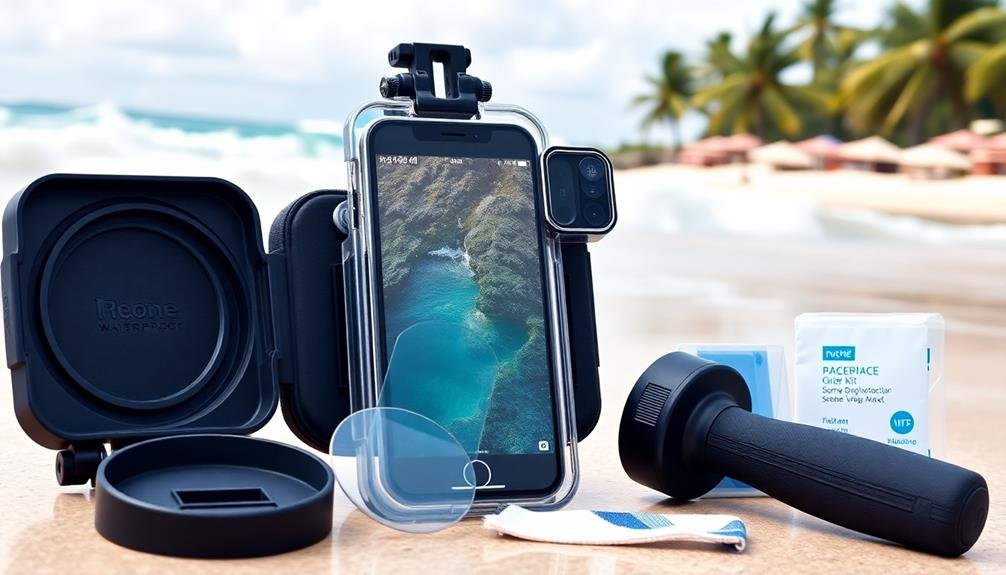
When it comes to protecting your smartphone camera while traveling, you'll want to invest in some key accessories.
Start with a sturdy case or cover that can shield your device from impacts and environmental hazards.
Don't forget to add a quality screen protector and consider specialized lens attachments to enhance your photography capabilities while safeguarding your phone's built-in camera.
Sturdy Cases and Covers
A robust case or cover is your smartphone camera's first line of defense against the rigors of travel. When selecting a case, prioritize those with raised edges around the screen and camera lens to protect against scratches and impacts.
Look for cases made from shock-absorbing materials like silicone or TPU, which can cushion your device during accidental drops.
For extreme environments, consider waterproof cases that allow full functionality while protecting your phone from moisture, dust, and debris. These are especially useful for beach trips, water sports, or hiking in unpredictable weather.
Remember that even with a waterproof case, you shouldn't submerge your phone for extended periods.
Some cases offer additional features that enhance your photography experience:
- Built-in lens covers that slide open when you're ready to shoot
- Attachment points for add-on lenses or filters
- Integrated kickstands for stable time-lapse or long-exposure shots
When you're not actively using your phone, a padded sleeve or pouch can provide an extra layer of protection in your bag.
This helps prevent scratches from keys or other items and offers cushioning against minor bumps during transit.
Screen Protectors and Lenses
Screen protectors and specialized lens accessories provide an extra layer of defense for your smartphone's most vulnerable components.
For your screen, opt for tempered glass protectors that can absorb impacts and prevent scratches. These are easy to apply and can be replaced if damaged, saving your actual screen from harm.
When it comes to lenses, invest in high-quality protective filters. UV filters not only shield your camera lens from scratches and dust but also reduce glare and improve image quality in bright conditions.
If you're using add-on lenses for wide-angle or macro shots, make certain they come with lens caps and protective cases.
Consider lens hoods for your smartphone camera, especially if you're shooting in challenging lighting conditions. They'll help prevent lens flare and protect against accidental bumps.
For underwater photography, look into waterproof cases with built-in lens protection.
Don't forget to clean your screen protector and lenses regularly with a microfiber cloth. Avoid using harsh chemicals or abrasive materials.
Frequently Asked Questions
Can Smartphone Cameras Be Damaged by Exposure to Direct Sunlight?
Yes, your smartphone camera can be damaged by direct sunlight exposure. It can overheat the lens, sensor, and other components, potentially causing permanent harm. You'll want to keep your device shaded when not in use outdoors.
How Often Should I Calibrate My Smartphone's Camera for Optimal Performance?
You don't need to calibrate your smartphone's camera regularly. It's typically self-calibrating. However, if you notice issues with focus or color accuracy, you can try recalibrating through your phone's settings or a third-party app.
Are Smartphone Cameras Affected by Airplane Mode During Flights?
No, airplane mode doesn't affect your smartphone's camera functionality. You can still take photos and videos while in flight. However, you won't be able to share or upload them until you're back online after landing.
Can Using Non-Manufacturer Camera Apps Impact My Smartphone Camera's Longevity?
Generally, non-manufacturer camera apps won't harm your smartphone camera's longevity. They're just software interfaces. However, if you're using apps that push your camera to its limits constantly, it might lead to faster wear over time.
What Should I Do if My Smartphone Camera Suddenly Stops Focusing Properly?
If your smartphone camera won't focus, try cleaning the lens gently. Restart your phone and clear the camera app's cache. If issues persist, check for software updates or consider seeking professional repair. Don't attempt to fix it yourself.
In Summary
You've learned essential tips for caring for your smartphone camera while traveling. Remember to protect your device, keep it clean, and store it properly. Be mindful of temperature extremes and environmental factors. Don't forget to update your software and back up your photos regularly. With these practices, you'll guarantee your smartphone camera is always ready to capture your travel memories. By taking good care of your device, you'll enjoy high-quality photos throughout your adventures.

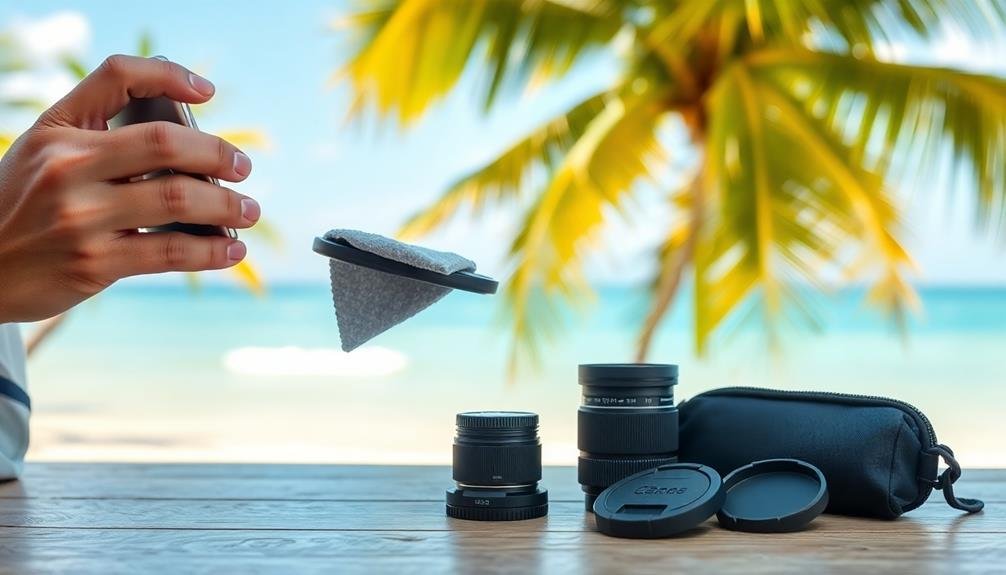

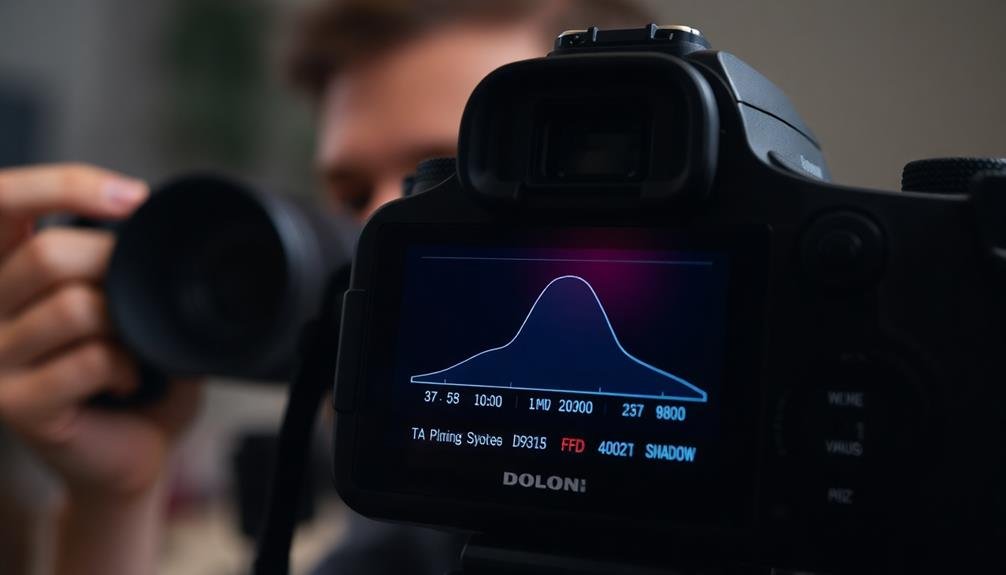
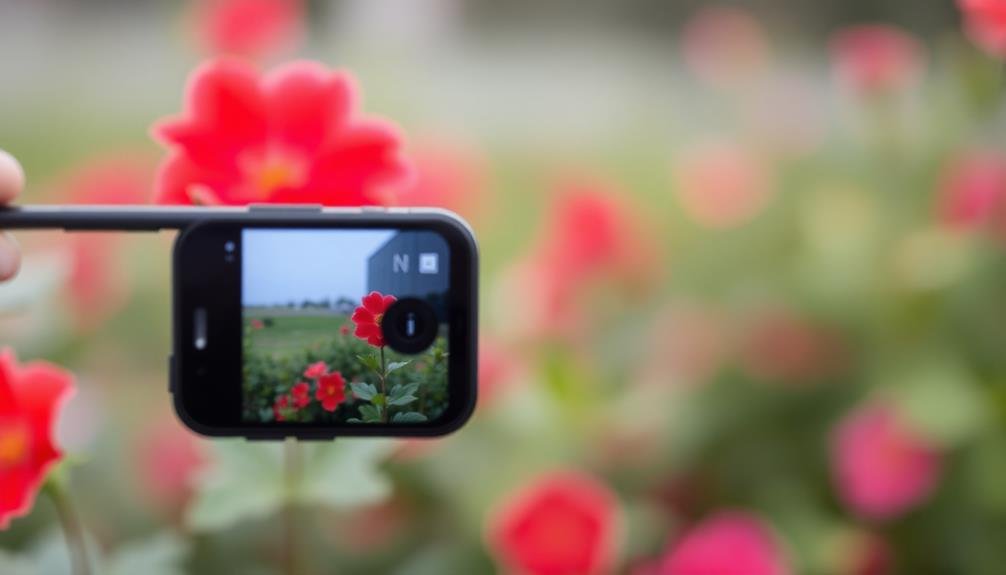
Leave a Reply